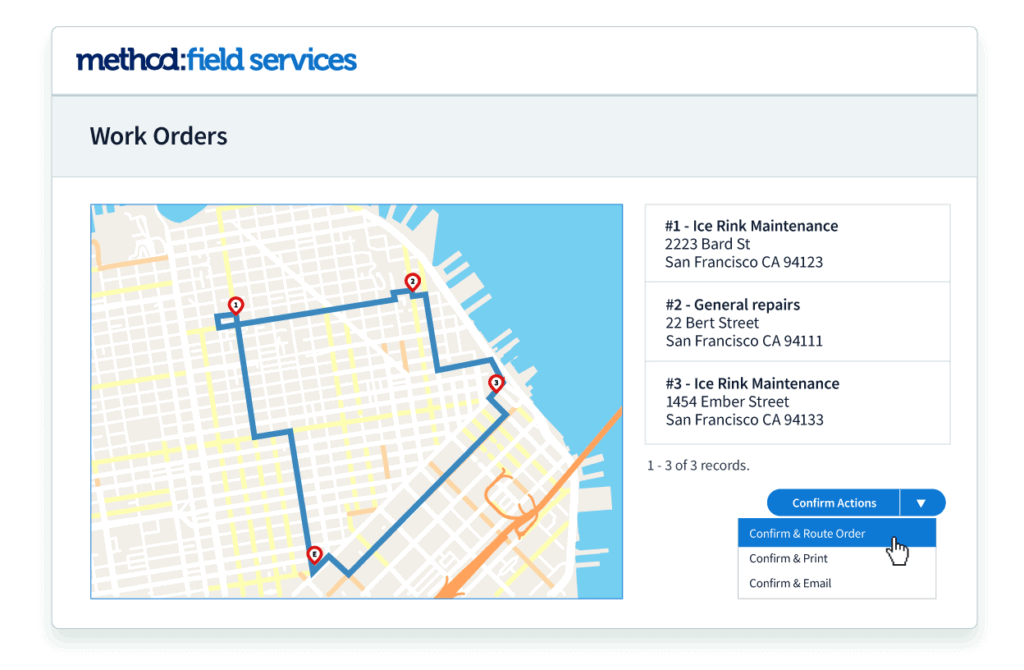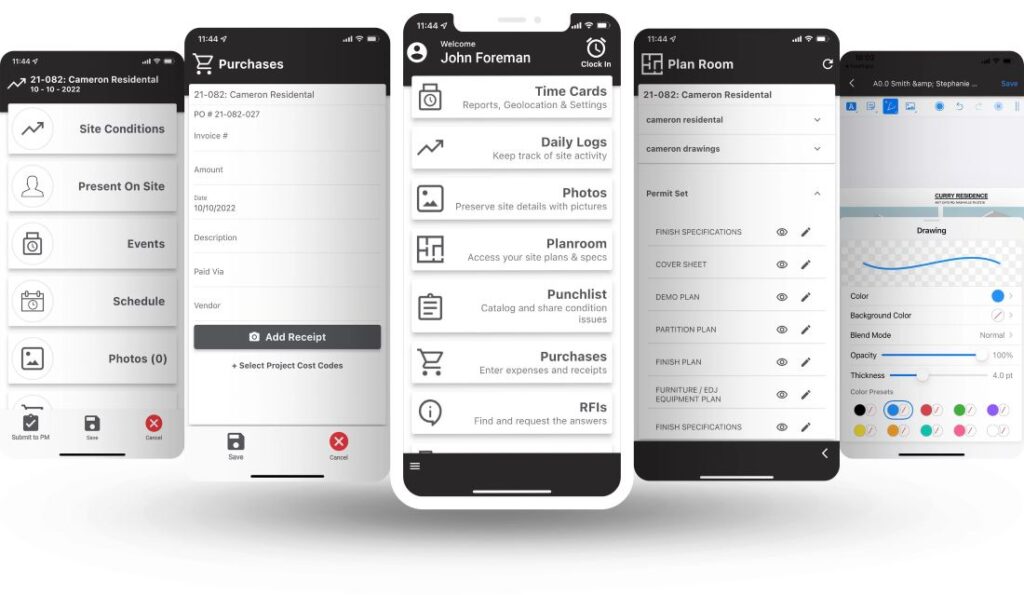Staying on top of resource allocation, task management, and project planning is challenging for construction businesses. This is where construction resource management software comes into play. It supports your day-to-day operations to increase your business’ productivity and profitability.
In this article, you’ll explore:
- What construction software is.
- How it impacts your business operations with scheduling, resource allocation, and tracking capabilities.
- Key features to keep your eye out for.
- The top solutions for 2024, based on features and user reviews.
You’ll also see the role it plays in the construction industry, its impact on project delivery, and future trends that are shaping the landscape.
What is construction resource management software?
Construction resource management software is a powerful tool for contractors that enhances project efficiency and facilitates team collaboration. It acts as a central hub for all project-related information, allowing teams to use time effectively and increase productivity. This software:
- Optimizes resource allocation.
- Automates scheduling.
- Provides real-time tracking and reporting.
- Boosts communication among teams.
Benefits of using construction resource management software
- Streamlines task management: Staying organized is crucial for a small construction business. This software simplifies task management by providing a centralized platform to assign, prioritize, and update tasks. This ensures everyone is on the same page and working towards common goals.
- Optimizes resource allocation: An efficient use of resources is the cornerstone of successful construction projects. This software allows you to analyze your productivity to allocate equipment, materials, and labor based on availability, ensuring you use resources effectively and meet budgets.
- Automates scheduling: We’re past the days of manual scheduling. This software automates the scheduling process and manages project timelines to help you meet deadlines.
- Provides real-time tracking and reporting: With the ability to monitor and track project progress through mobile apps, you can make informed decisions on the spot. This software generates detailed reports with valuable real-time insights for construction project managers and stakeholders.
- Boosts communication among teams: Effective communication is vital in the construction industry. This software enhances communication by providing tools for team members to collaborate, share information, and prioritize tasks.
Types of construction resource management software
There are two main types of software: cloud-based solutions and on-premise solutions.
Cloud-based solutions
This software allows for cloud-based storage and access and offers the advantage of accessibility from anywhere in the world. It allows teams to collaborate seamlessly, even if they are not in the same physical location.
On-premise solutions
On-premise solutions, on the other hand, are installed on your company’s servers and accessible only from your physical office, so offline access is possible. While they provide more control over your data, they do not offer the same accessibility as cloud-based solutions.
Exploring key features of construction resource management software
To fully understand the capabilities of construction resource management software, let’s get into some key features.
Project scheduling
Setbacks are common in the construction industry, so the nature of construction requires efficient project scheduling to meet deadlines and stay on budget. This software allows you to keep stakeholders aligned and working toward the same goal by:
- Creating precise timelines for every task and identifying roadblocks.
- Prioritizing tasks based on deadlines and available resources.
- Efficiently communicating updates on the job site.
Project documents and document management
This software simplifies document management by providing a centralized location for all project-related documents. As a result:
- Essential information is easily accessible to authorized team members.
- Manual tasks like data entry are reduced.
- Version control improves so you don’t work on outdated documents or rely on incorrect information.
- You can organize your information efficiently without needing a physical archive.
Task management
Construction projects often involve overlapping tasks and priorities. Software coordinates task assignment based on dependencies, resource availability, and timelines, so nothing falls through the cracks.
Team collaboration and communication tools
Collaboration among team members is streamlined with built-in communication tools. Share updates, assign tasks, and communicate instantly so everyone is on the same page.
Real-time data tracking and reporting
Monitor project progress in real-time and generate detailed reports to evaluate performance and make data-driven decisions.
The pivotal role of construction resource management software in the construction industry
Construction resource management software supports financial control, enhances project efficiency, facilitates collaboration between participants, and simplifies procurement processes. It also ensures that all project stakeholders, from project managers to contractors, work efficiently to drive project success.
Successful construction companies need to avoid resource wastage, which often happens when task coordination and scheduling are not optimal. Construction software increases profitability by reducing labor costs and material wastage.
How resource management streamlines management processes
Resource management simplification
Construction resource management software simplifies the complex task of resource allocation by keeping track of resource availability. In turn, project managers and contractors can ensure that equipment, materials, and labor are used optimally to minimize waste and cost overruns.
Gantt chart timeline utilization

Image credit: Motion
Project managers can manage Gantt chart timelines with ease to kickstart dependent tasks and identify possible roadblocks in each process. The visual representation of project schedules helps in prioritizing tasks and resources effectively.
Progress visualization techniques
Visualizing project progress through graphs and dashboards makes it easier to identify bottlenecks and make necessary adjustments. It also supports improved collaboration among team members by enabling them to flag roadblocks and ask for help when needed.
Tasks comments and attachments management
Detailed task comments and attachments help teams work effectively, ensuring that everyone has access to essential project information and speeding up project updates.
Online notifications for efficiency
Notifications keep team members updated about task assignments, changes, and updates, promote efficiency, and reduce communication gaps.
Enhanced financial control
Effective financial control is essential for the success of any construction project. Construction resource management software lets you manage budgets, track costs, and forecast expenses accurately so that you can assign a realistic budget to each task.
Export and sharing capabilities
This software facilitates export and sharing of data and reports, which is key for collaboration with clients, stakeholders, and team members.
Strategic project planning
You can plan future projects with an analysis of project data. This helps you avoid repeating inefficient processes and increases your productivity.
Top construction resource management software of 2024
In 2024, several construction resource management software solutions stand out for their effectiveness in enhancing construction project management. Users have given them great reviews, and a number of people rely on them to manage their businesses. Below are the top picks.
Method:Field Services

Method:Field Services is a highly-rated construction management software that is versatile and user-friendly. This tool is designed to streamline lead-to-cash workflows from estimate creation to deposit collection and job scheduling. It is particularly beneficial for small construction companies that need to improve their customer experience and operations. It also offers a free trial.
Key features
- Project management: Method:Field Services provides a centralized platform for managing construction projects. You can create, assign, and track work orders, ensuring that a job progresses smoothly.
- Scheduling: Along with other notable features, Method:Field Services helps you create detailed project schedules and construction times. Its scheduling tools help you allocate resources effectively, ensuring that projects are completed on time and in budget.
- Fieldwork management: With this cloud-based software, you can track the progress of your team and communicate with them in real-time.
- Client Relationship Management (CRM): From nurturing potential clients to receiving payments and approvals for jobs Method:Field Services makes sure that you tend to your clients’ needs.
- Customization: Tailor Method:Field Services to your specific needs, all without having to code! You can create custom fields, workflows, and reports to mold the software to your unique business processes.
- Two-way real-time sync: Method:Field Services integrates with existing systems such as QuickBooks and Xero to simplify data transfer and ensure all your systems work together. This integration will help you with estimation, pricing, and profitability analytics.
GanttPro

Image credit: GanttPro
GanttPro is a robust construction project management software that excels in efficient scheduling and resource allocation. Its primary strength lies in its visual representation of project timelines through Gantt charts, which makes project planning and tracking intuitive.
Key features
- Gantt chart visualization: GanttPro’s standout feature is its user-friendly Gantt chart interface. It allows you to easily manage project timelines, making allocating resources, assigning tasks, and prioritizing work simple.
- Collaboration: The software supports collaboration in larger teams by allowing them to view and update project timelines. This promotes transparency and ensures that everyone is on the same page.
- Resource management: GanttPro provides tools for resource allocation, helping you assign team members, equipment, and materials to specific tasks.
- Progress tracking: This tool enables progress visualization with features that let you identify delays or bottlenecks and make necessary adjustments to keep the project on track.
RedTeam

Image credit: RedTeam
RedTeam is a comprehensive construction management solution that covers resource tracking, financial management, and document control. It caters to the specific needs of construction businesses, making it an excellent choice for contractors looking to simplify their operations.
Key features
- Project tracking: RedTeam allows you to monitor progress, costs, and schedules. This helps you make informed decisions and keep projects in budget.
- Financial management: Managing finances in construction is critical, and RedTeam excels in this area. It supports invoicing, cost and budget tracking, and estimating so your projects remain financially viable.
- Document control: Keeping track of construction documents is made easy with RedTeam. It offers document management tools that centralize all project-related documents, which improves data accuracy and accessibility.
Autodesk Build

Image credit: Autodesk Build
Autodesk Build is a cloud-based construction management platform that offers end-to-end project management capabilities. It stands out for its design software, making it a valuable tool for construction companies looking for a seamless design-to-construction workflow.
Key features
- Project management: Autodesk Build provides comprehensive project management tools that cover everything from document control to subcontractor management. It assists in project planning, helps you create a construction resource management plan, and offers a centralized platform to track and manage all project-related information.
- Design software: One of its unique strengths is its design software. This feature allows for a smooth transition from design to construction, ensuring that design plans are seamlessly implemented and updated on the go.
- Collaboration: The software promotes collaboration among project stakeholders, allowing them to share information and updates in real time. This fosters efficient communication and guarantees that everyone is aligned with project objectives.
- Quality management: Autodesk Build tracks issues and supports workflows to resolve them without delaying the project. This ensures that the final product is up to par with your client’s standards and expectations.
- Safety control: This system allows you to communicate safety measures to your construction crews to avoid workplace accidents and support workers’ well-being.
Jobber

Image credit: Jobber
Jobber is a field service management software tailored for small businesses in the trades industry. It offers features for scheduling, dispatching, and client management, making it an excellent choice for companies looking to simplify their operations and provide top-notch service.
Key features
- Scheduling: You can assign tasks to your construction teams, optimize routes, and schedule appointments.
- Client management: It includes features for managing client information, such as contact details, construction agreements, and communication logs. This helps you provide personalized service, maintain strong client relationships, and create a good customer experience.
- Invoicing and payments: You can create and send invoices, track payments, and provide multiple payment options to your clients.
- Dispatching: For field service operations and job site activities, dispatching is crucial. Jobber’s dispatching tools help you assign jobs to your team members, ensuring that they have all the information and materials they need to complete tasks efficiently.
- Mobile access: Construction crews can access Jobber through an app on their mobile devices, enabling them to view job details, navigate to job sites, and update progress in real time.
These top construction resource management software offer a range of features to cater to the diverse needs of small construction businesses. Whether you need robust project management, efficient scheduling, financial control, or field service management, a software solution can help you simplify your operations and enhance project efficiency.
Future trends in construction resource management
As technology continues to evolve, the construction industry is also undergoing significant changes. Here are some future trends that will shape the landscape of construction resource management.
Increased adoption of technology
The construction industry is embracing technology at an unprecedented rate. From drones to advanced software solutions, technology is transforming how construction companies operate.
Use of advanced building materials
The use of advanced and sustainable building materials is on the rise. Construction resource management software is crucial in tracking and managing these materials efficiently, given that procuring and using them can entail the creation of new techniques and workflows that outperform manual methods.
Growing prominence for modular construction
The housing crisis in North America encourages modular construction approaches, which involve prefabricating building components in a factory. Construction resource management software supports the planning of modular construction approaches by supporting the creation of new kinds of workflows.
Emphasis on sustainable practices
The construction industry now promotes sustainable practices, given that non-renewable resources will become less available over time. This calls for an industry that accommodates advanced building materials. Construction software solutions will aid in monitoring and implementing sustainable practices, such as energy-efficient building designs and materials.
Better workers’ safety measures
Worker safety is paramount in construction. Software aids in workers’ safety measures by:
- Tracking safety protocols.
- Reducing accidents.
- Ensuring a safe working environment.
Key takeaways
Construction resource management software is a game-changer for construction businesses looking to enhance project efficiency, facilitate team collaboration, and streamline management processes. Planning your days around priorities and establishing workflows will help you build an excellent foundation for your growing business.
A software solution can be a great ally in your journey to increase profitability, providing you with the tools to implement the changes you want for your business. Communicating better with your team and fulfilling tasks when needed can make a huge difference.
By optimizing resource allocation, automating scheduling, providing real-time visibility and reporting, and boosting communication among project teams, this software empowers businesses to thrive in the competitive world of construction.
Frequently asked questions (FAQs)
How does construction resource management software impact project delivery?
Construction resource management software improves project delivery by enhancing efficiency, streamlining communication, and providing real-time detailed tracking and reporting.
It ensures that resources are allocated optimally, reducing delays and cost overruns. It also empowers project managers and contractors to use all the available resources as best as possible.
These improvements ultimately help you provide your clients with more realistic costs and delivery dates and create an accurate roadmap of what needs to happen to deliver on time.
What is the difference between cloud-based and on-premise solutions?
Cloud-based solutions are accessible from anywhere via the internet and promote collaboration among remote teams. On-premise solutions are installed on company servers and offer more control over data but may lack accessibility. As technology becomes more advanced, cloud-based solutions increase in popularity.
How are future trends influencing the construction resource management landscape?
Future trends in construction, such as increased technology adoption, modular construction, and sustainable materials, are shaping construction resource management by calling for workflows that include new construction techniques and material providers.
Grow your business, not your stress. Watch free demo
Image credit: Pexels


